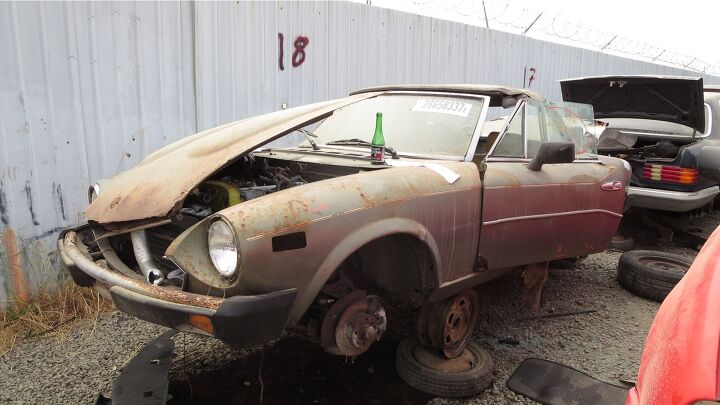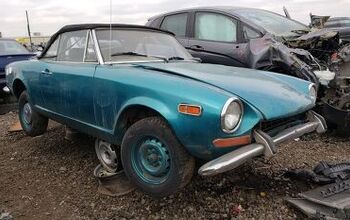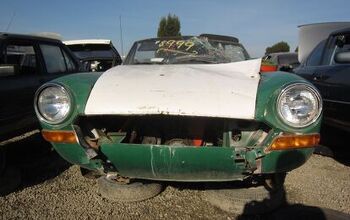Junkyard Find: 1979 Fiat 124 Sport Spider

For as long as I have been poking around in American automobile graveyards (35 years), the presence of the occasional Fiat 124 Sport Spider has been a constant. Even while Pininfarina-badged, Malcolm Bricklin-imported 124 Sport Spiders were still available as new cars in the United States, I was seeing 20,000-mile late-70s examples about to be crushed.
Nowadays, most of these cars show signs of decades-long outdoor storage after awaiting restorations that never came. Here’s an extremely rough and rusty one that I spotted in a San Francisco Bay Area yard a couple of months back.
How many of these cars have we seen in this series? Many. This ’71, this ’73, this ’75, this ’76, this ’78, this ’80, this ’80, and this ’80 (plus this ’80 in the Junkyard Treasures Series on Autoweek). That doesn’t count the many I didn’t bother to photograph, of course.
Like many older cars found in Bay Area wrecking yards, this one has ancient military-base parking permits. Having grown up in a Bay Area city with a huge Navy base, I’m familiar with the acres-wide long-term storage lots on bases where soldiers and sailors stored their often-quite-hooptified vehicles, and this car has the look of one that spent 25 or so years at the Mare Island Naval Complex (not far from this yard), getting the paint burned off by the sun and the metal rusted by the rainy winters.
Cars do rust in California, sometimes very thoroughly in the case of close-to-the-Pacific parking places, and they tend to do it from the top down. This car has rust where rainwater gathered and where the paint failed.
This is the only Fiat 124 I have ever seen with air conditioning. This looks like an aftermarket (probably dealer-installed) unit.
With only 86 horsepower available from the 1,995cc Fiat Twin Cam four-cylinder engine, acceleration with the AC on must have been leisurely. This car had a curb weight of 2,240 pounds, which gave it 26.05 pounds for each horsepower; compare that to the 62.5-horse/2,338-lb 1979 MGB and its 37.41 pounds-per-horsepower (or to the 2017 Fiat 124 Spider and its 15.26 lbs/hp ratio).
Worth restoring? Hell no, not when you can get a nice one for five grand. Some useful parts are here, though, and we can hope that they get rescued before The Crusher digests this old Italian.
“Engineered for the Eighties.”

Murilee Martin is the pen name of Phil Greden, a writer who has lived in Minnesota, California, Georgia and (now) Colorado. He has toiled at copywriting, technical writing, junkmail writing, fiction writing and now automotive writing. He has owned many terrible vehicles and some good ones. He spends a great deal of time in self-service junkyards. These days, he writes for publications including Autoweek, Autoblog, Hagerty, The Truth About Cars and Capital One.
More by Murilee Martin
Latest Car Reviews
Read moreLatest Product Reviews
Read moreRecent Comments
- Theflyersfan OK, I'm going to stretch the words "positive change" to the breaking point here, but there might be some positive change going on with the beaver grille here. This picture was at Car and Driver. You'll notice that the grille now dives into a larger lower air intake instead of really standing out in a sea of plastic. In darker colors like this blue, it somewhat conceals the absolute obscene amount of real estate this unneeded monstrosity of a failed styling attempt takes up. The Euro front plate might be hiding some sins as well. You be the judge.
- Theflyersfan I know given the body style they'll sell dozens, but for those of us who grew up wanting a nice Prelude Si with 4WS but our student budgets said no way, it'd be interesting to see if Honda can persuade GenX-ers to open their wallets for one. Civic Type-R powertrain in a coupe body style? Mild hybrid if they have to? The holy grail will still be if Honda gives the ultimate middle finger towards all things EV and hybrid, hides a few engineers in the basement away from spy cameras and leaks, comes up with a limited run of 9,000 rpm engines and gives us the last gasp of the S2000 once again. A send off to remind us of when once they screamed before everything sounds like a whirring appliance.
- Jeff Nice concept car. One can only dream.
- Funky D The problem is not exclusively the cost of the vehicle. The problem is that there are too few use cases for BEVs that couldn't be done by a plug-in hybrid, with the latter having the ability to do long-range trips without requiring lengthy recharging and being better able to function in really cold climates.In our particular case, a plug-in hybrid would run in all electric mode for the vast majority of the miles we would drive on a regular basis. It would also charge faster and the battery replacement should be less expensive than its BEV counterpart.So the answer for me is a polite, but firm NO.
- 3SpeedAutomatic 2012 Ford Escape V6 FWD at 147k miles:Just went thru a heavy maintenance cycle: full brake job with rotors and drums, replace top & bottom radiator hoses, radiator flush, transmission flush, replace valve cover gaskets (still leaks oil, but not as bad as before), & fan belt. Also, #4 fuel injector locked up. About $4.5k spread over 19 months. Sole means of transportation, so don't mind spending the money for reliability. Was going to replace prior to the above maintenance cycle, but COVID screwed up the market ( $4k markup over sticker including $400 for nitrogen in the tires), so bit the bullet. Now serious about replacing, but waiting for used and/or new car prices to fall a bit more. Have my eye on a particular SUV. Last I checked, had a $2.5k discount with great interest rate (better than my CU) for financing. Will keep on driving Escape as long as A/C works. 🚗🚗🚗





















































Comments
Join the conversation
There were actually two Fiat sports cars in those days. Mine was the little one, the 850 Spider. 2-seats, soft top, rear engine, electrical problems that took your breath away but a total high-rev little blast of a car. Mine was mustard yellow. No knobs, everything was a toggle switch. And it was my first car with an FM radio except the car was too noisy to hear it. Loved it every day. Always will.
Yes! The 124 was the Big, Luxury Spyder for fancy people. My sister had its bouncing baby brother, the 850 Spyder, in college...I suppose that signified 850 ccs, because "that washing machine engine," as my dad called it, couldn't have been packing more than one liter. My god, that little 850 Spyder was cute, bright red and sized perfectly for a 10 year old...I freakin loved it. By the time I was of driving age, there were plenty of beautiful 124 Spyders and Alfa Romeo Spyders for that matter available in the local Auto Trader for very reasonable prices: it was the Age of the Miata and the pretty, classic Italians had cratered in value. No 850s left to speak of by that time though, they'd all died of rust or parts shortages. Well, except for one: the screaming-orange one owned by the weekend racer up the street. Every weekday morning he'd give the thing an Italian tuneup: redline it in first gear, then floor the brake pedal to absolutely no effect...when the car eventually drifted to a stop of its own accord, he'd redline it in reverse and then ineffectually floor the brake pedal...back and forth he'd go until the racing pads had warmed up enough to safely drive the car to work. I suppose he did the same thing in the work parking lot every day after work too. Nutty SOB, in the best way.